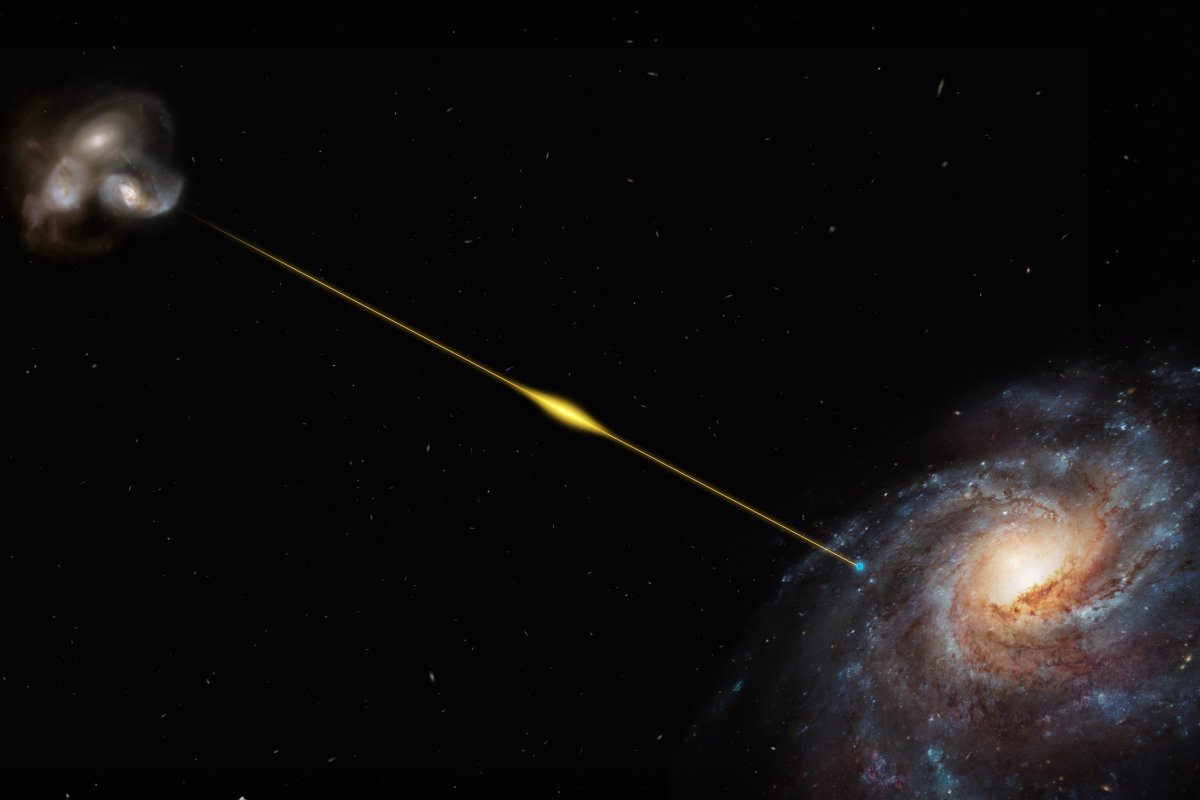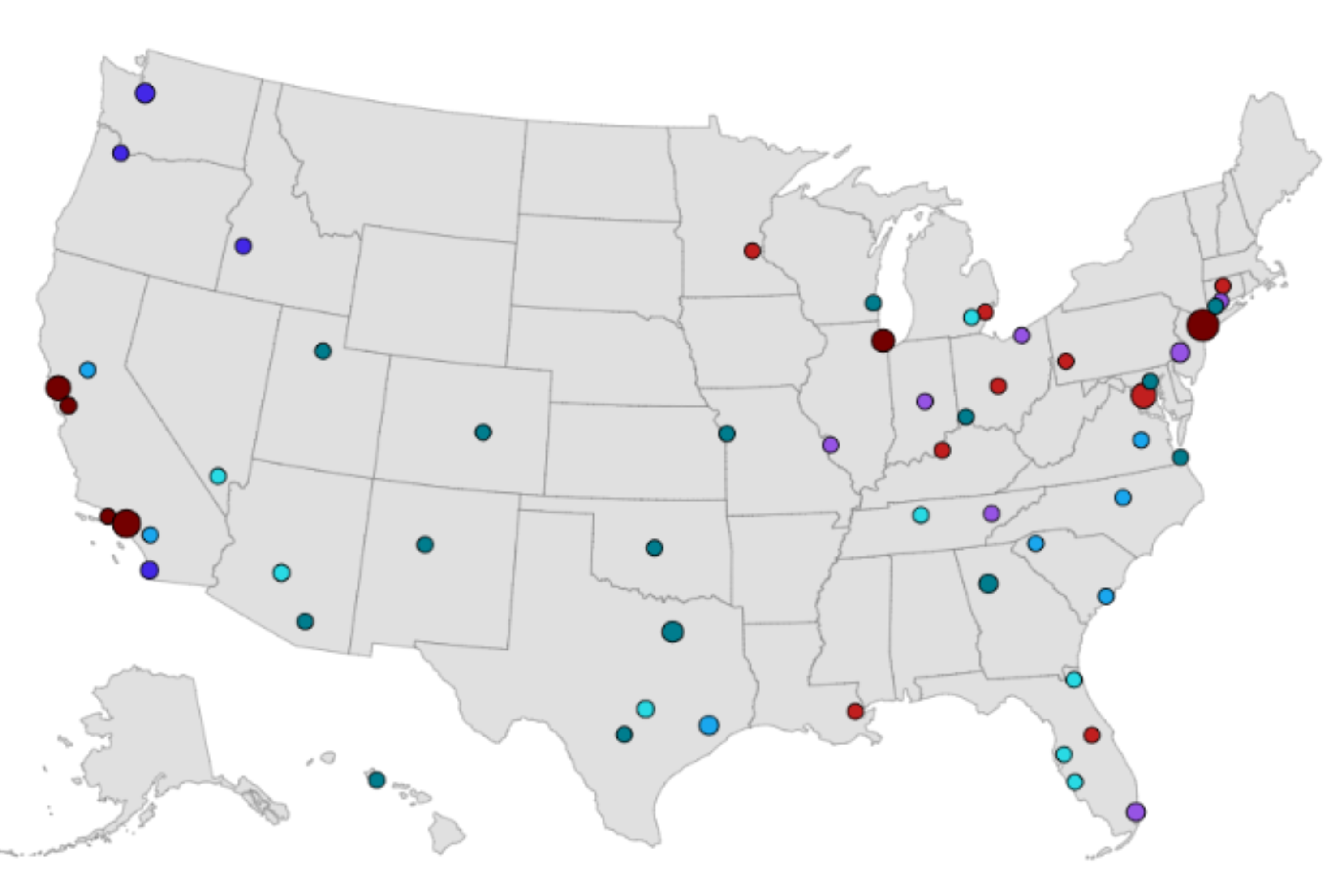Astronomers have detected a mysterious—and record-breaking—signal originating from so far away in the distant universe that it took 8 billion years to reach us.
The unusual signal, described in a paper published in the journal Science, represents a type of cosmic phenomenon known as "fast radio bursts" or FRBs.
FRBs are intense but very brief pulses of radio waves—the same type of radiation emitted by your cell phone or a microwave—that originate from distant sources in the universe.
Even though astronomers have the world's most sensitive radio telescopes and supercomputing systems at their disposal, looking for FRBs is like searching for a needle in a haystack.

"They last only a small fraction of a second," Ryan Shannon, an author of the latest study with Swinburne University of Technology in Australia, told Newsweek.
"Most FRBs are not seen to repeat, meaning if we want to understand what they are or where they come from, we need to be quick to respond, and gather as much detail about them in the few thousandths of the second they pass by Earth."
The FRB identified in the latest study (labeled FRB 20220610A) is notable because it is the most distant and ancient discovered to date—occurring around 8 billion years ago—as well as being unusually high-energy. The latest findings provide new insights into the distant universe and challenge current models of FRB emission, according to the authors.
Only around 50 FRBs have been detected to date. Given the relatively low sample size and difficulty in studying them, the source of these high-energy emissions remains something of a mystery.
"We now know that FRBs come from distant galaxies. This is very surprising given the intensity of emission. The only type of source known to emit similar emissions—pulsars in our own Milky Way galaxy—are a trillion times less energetic. This has created a major conundrum for astronomers: how is it possible to generate such intense pulses of emission?" Shannon said.
"While we still don't know precisely what causes them—determining that will be a tall task—we are still able to use them as tools. FRBs are imprinted with the signature of all of the gas they travel through. This makes them incredibly useful for probing the tenuous gas that resides between galaxies."
While this intergalactic space is nearly empty, most of the normal matter in the universe—the matter that stars and planets consist of—is found in these regions.
"Our team was previously able to use FRBs to detect this missing matter in the nearby universe. Understanding the nature of this matter is crucial for figuring out how galaxies evolve as it sculpts and shapes galaxies and provides the fuel for forming stars like the sun," Shannon said.
There is some evidence that FRBs are produced by magnetars, which are young, hyper-magnetized neutron stars. Neutron stars are dense stars that have roughly the same mass as the sun but are only the size of a small city with extremely strong magnetic fields.
"These are some of the most extreme objects in the universe, so it is natural to implicate them in producing extreme radio bursts. Indeed, an FRB-like burst was observed from a magnetar in our own galaxy in 2020," Shannon said.
"However, some FRB signals have been found coming from places thought to be devoid of magnetars, so there is a possibility that more than one type of object could produce an FRB. That would be very exciting!"
In the latest study, a team of researchers describe an FRB that was detected on June 10, 2022 by the Australian SKA Pathfinder (ASKAP)—a radio telescope located in the west of the country.
The researchers then determined the distance and time that the FRB had traveled between where it originated and where it was detected. They found that the burst came from a very distant host galaxy and had traveled 8 billion years before arriving at the ASKAP.
"The telescope site is ideal for FRB hunting as it is in a very remote location, meaning there are fewer human-produced signals which can interfere with FRB searches," Shannon said. "With ASKAP we were able to pinpoint the burst to a position close to the Sculptor constellation in the southern hemisphere, to a precision sufficient to determine in which galaxy the FRB originated."
This latest discovery has broken the record for most distant FRB by around 50 percent, while confirming that such phenomena are present in very distant galaxies, according to Shannon.
"This FRB showed evidence for traveling through a large amount of gas. From the burst we could also tell that the gas was relatively placid. Despite the burst coming from a great distance it was very bright," Shannon said. "[FRB] bursts are incredibly powerful with this being one of the most powerful."
In fact, FRB 20220610A emitted more energy in the space of a few milliseconds than the sun does in 30 years, according to Shannon,
At present, it is unclear if the host of this FRB is one galaxy or a small group of galaxies. Determining the true nature of the host will require higher definition images, obtainable with observatories such as Hubble and the James Webb Space Telescope. Nevertheless, the researchers said the latest study has several implications.
"The discovery confirms that FRBs can be used to study the frontiers of the universe, including what the cosmic web looks like when the universe was in its infancy," Shannon said. "With more next-generation telescopes it should be possible to detect FRBs at even greater distances, and detect larger samples of FRBs to map the cosmic web."
"The burst also pushes the limits of FRB energetics. Detailed theories for producing FRB emission need to be able to produce pulses more intense than previously thought."
Shi Dai, an astronomer at Western Sydney University in Australia who was not involved in the latest study, told Newsweek that given its large distance, FRB 20220610A is "extremely" energetic, adding that the Science paper has shed new light on the origin of these phenomena.
Update 10/23/23, 1:50 p.m. ET: This article was updated with comments from Shi Dai.
Uncommon Knowledge
Newsweek is committed to challenging conventional wisdom and finding connections in the search for common ground.
Newsweek is committed to challenging conventional wisdom and finding connections in the search for common ground.
About the writer
Aristos is a Newsweek science reporter with the London, U.K., bureau. He reports on science and health topics, including; animal, ... Read more
To read how Newsweek uses AI as a newsroom tool, Click here.








